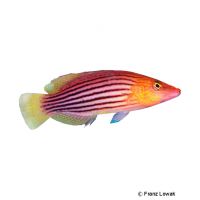Eightline Wrasse (Pseudocheilinus octotaenia)
| Eightline Wrasse Pseudocheilinus octotaenia | |
|---|---|
| Name | Eightline Wrasse |
| Name Lat. | Pseudocheilinus octotaenia |
| Family | Wrasses |
| Family lat. | Labridae |
| Order | Wrasses & Relatives |
| Order lat. | Labriformes |
| Origin | Indo-Pacific |
| Habitat | Lagoons, seaward reefs |
| Diet | Planktivore |
| pH | 8.1-8.4 |
| Hardness | 8-10 °KH |
| Behavior | Aggressive |
| Keeping | Individual |
| Reef Compatible | Yes |
| Care Level | Difficult |
| Life Span | 2-3 years |
| Protection | No |
| Metric Units | |
| Size | 14 cm |
| Temperature | 22-28 °C |
| Salinity | 33-36 ‰ |
| Aquarium | ~ 350 l |
| US Units | |
| Size | 5" |
| Temperature | 72-82 °F |
| Salinity | 1.020-1.025 sg |
| Aquarium | ~ 90 gal |
Distribution and habitat
Pseudocheilinus octotaenia have a wide range, extending throughout the tropical Indian and Pacific Oceans, from the east coast of Africa to the west coast of America, and from Hawaii to Australia. They live solitary mostly in caves and crevices on outer reefs with dense coral growth and in lagoons up to 40 m depth.
Maintenance
They need a well-structured aquarium with plenty of swimming space and a reef structure (hiding, resting and retreat possibilities) with living stones that act like a biological filter as well as free sand areas (no coral rubble!) for burrowing
Only lime-rich, heavy metal-free substrates may be used as substrate. Filters, skimmers and heaters are necessary to ensure water quality, as well as pumps to simulate tides, swells and bottom currents. Lighting must match the species-appropriate day-night rhythm of the animals
| Salinity: 33-36 ‰ | pH value: 8.1-8.4 |
| Carbonate hardness: 8-10 °KH | Nitrate content: 2-8 mg/l |
| phosphate content: 0.01-0.1 mg/l | nitrite content: 0.0-0.05 mg/l |
For salinity, an average value should be aimed for, which may only vary slightly by +/- 0.5 ‰. Ammonia and ammonium must not be measurable. Special attention must be paid to constantly good water quality.
Diet
In nature they feed mainly on zooplankton. The feed change usually succeeds without problems. The food supply should consist of a combination of small mysis, artemia and cyclops. In addition, chopped shrimp and crab meat as well as a frozen food mixture enriched with vitamins for plankton eaters. High-quality flake and granulated food is also often accepted after an acclimation period
It is recommended to feed small portions several times a day. This also reduces intra-species aggression and protects lower animals in the aquarium. Regular and varied feeding promotes health and increases resistance.
Behaviour and compatibility
They behave very aggressive within the species and also against other fish. Keeping several animals is only possible in a much larger and richly structured tank. They should only be kept together with other large and robust fish that can defend themselves well.
Sex dimorphism
They are protogynous hermaphrodites, meaning that most males develop from functional females and are called "secondary males". "Primary males" are born as males. External sexual characteristics are not known.
Reproduction and breeding
There are no known reports of successful breeding in the aquarium.
Important
They also eat parasitic micro snails (Pyramidellidae), planarians and bristle worms and prevent their uncontrolled reproduction
Overnight and when threatened, they bury themselves in the sandy substrate
As coral reef dwellers, they should not be maintained in a fish-only aquarium.
If different species are kept together, care should be taken to match the fish in terms of water quality and temperature requirements and social behavior, and to ensure that the setup meets the needs of all species kept together. New fish to be introduced must be acclimated slowly to the water in the aquarium
Further literature can be found in your pet store.
References
Text: Werner Winter; Image: Franz Lowak
Source: KUITER, DEBELIUS (2007): Atlas der Meeresfische: Die Fische an den Küsten der Weltmeere, Kosmos Verlag; ENGELMANN (2005): Zootierhaltung - Tiere in menschlicher Obhut: Fische, Verlag Harri Deutsch
- Gemäß § 21 Abs. 5 Tierschutzgesetz idgF
